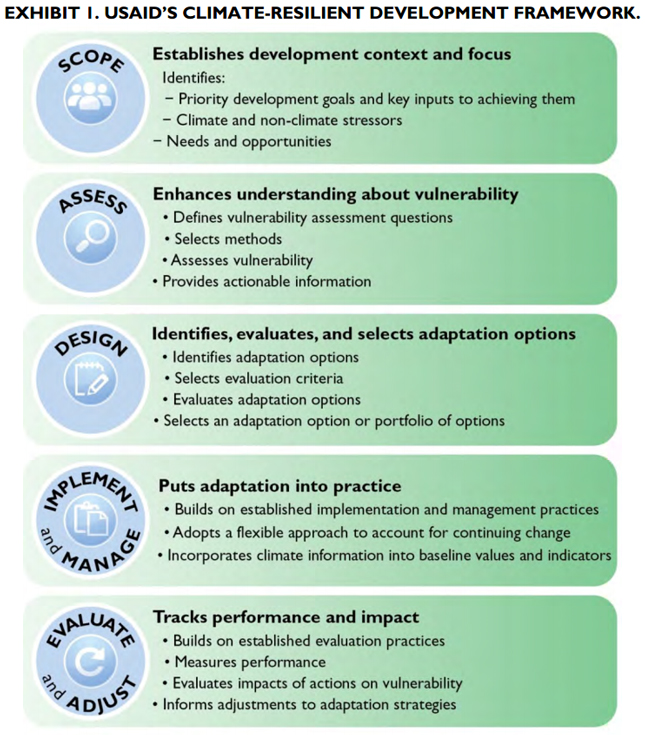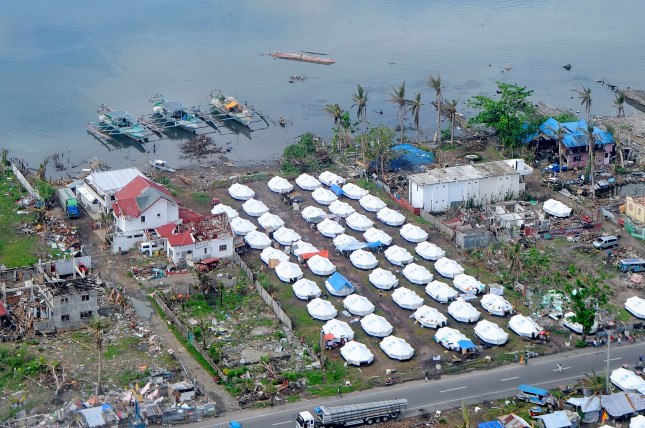-
A Closer Look at USAID’s Climate Strategy: Climate-Smart Development a Work in Progress
July 14, 2014 By Kathleen MogelgaardIn March, the Intergovernmental Panel on Climate Change released its latest comprehensive synthesis of climate change research. The report concludes that “impacts from recent climate-related extremes, such as heat waves, droughts, floods, cyclones, and wildfires, reveal significant vulnerability and exposure of some ecosystems and many human systems to current climate variability.”
Climate change is not a sector unto itself, nor is it a sub-sector of the environmentThe impacts of climate-related extremes, the report continues, include disruption of food production and water supplies, damage to infrastructure and settlements, increased morbidity and mortality, and consequences for mental health and general well-being. “For countries at all levels of development,” the report states, “these impacts are consistent with a significant lack of preparedness for current climate variability.”
Such findings highlight the cross-cutting character of the challenge: Climate change is not a sector unto itself, nor is it a sub-sector of “the environment,” but will touch on nearly every part of life. Understanding the risks posed to sectors such as water, health, infrastructure, women’s empowerment, agriculture, and food security is imperative to the long-term success of development efforts.
But integrating climate change into development can be daunting. It requires building capacity among planners and practitioners who are used to doing things differently, creating new guidelines and reporting requirements, and providing support for carrying out such integration, all in an environment – international aid – where human and financial resources are often already overtaxed.
Putting Development First
When the U.S. Agency for International Development (USAID) released its Climate Change and Development Strategy in January 2012, integration – mainstreaming climate change considerations into all of USAID’s work – was highlighted as a key priority.
USAID has taken some important steps to support such integration. The agency has produced guidance documents and tools to assist its bureaus, offices, and missions in assessing climate risks and integrating adaptive responses into their activities. USAID has initiated training programs for staff in Washington and country missions and supported integration pilot projects in several countries, including the development of a “climate-smart” agriculture curriculum in Guinea and building climate resilience strategies into efforts to strengthen governance structures for pastoralists in Ethiopia.
The framework employs a “development first” approachBut perhaps the biggest step forward in this integration effort came in April, when USAID released its Climate-Resilient Development Framework. This document, which is intended to be a tool for assisting USAID missions and implementing partners in mainstreaming climate change into their planning at the ground level, is the result of extensive testing and refining through a workshop process in Jamaica, after the Jamaican government asked for assistance in developing a national climate change policy, and experience in the Philippines, where a team of experts assessed water security and climate issues for the municipality of Iloilo.
The framework employs a “development first” approach, which USAID staff see as a critical factor for getting climate change on the table, and one that sets it apart from other assessment efforts that use climate data and projections as a starting point for planning.

“Where this framework adds value, where we differentiate ourselves from other processes, is the scoping phase,” said John Furlow, lead on adaptation in USAID’s Global Climate Change Office at a public event launching the framework.
We don’t start with climate information. We start the process by asking, ‘What drives the economy? What is important for livelihoods?’…We find that when you start by talking about what drives the economy, your stakeholders get to stay in their comfort zone; they get to talk about what they know best.
Identifying development goals is the first of a five-phase process outlined in USAID’s climate-resilient development framework (see Exhibit 1). After an initial broad scoping process, planners are encouraged to assess vulnerabilities and capacities; design actions to reduce the impact of climate and non-climate stressors; implement and manage the selected options; then evaluate and adjust.
Kathleen Mogelgaard on considering population, food, and climate together “The framework is not just for climate specialists, but enables those working in other sectors that might not be so familiar with climate to engage and address climate in their work,” said Bill Breed, division chief of USAID’s Global Climate Change Office at the launch event. “This is part of internalizing climate change in all our work.”
The report that outlines the framework is broad and conceptual, and at only 25 pages, does not provide detailed guidance for implementing the five phases. Instead, USAID says it intends the framework to be a “living document,” and over the coming months will release a number of in-depth annexes, focusing on topics such as vulnerability assessment, evaluating adaptation options, governance, and working with marginal populations, as well as more sector-specific guidance for water, coastal zones, and conflict.
From Words to Action?
In addition to releasing the framework and other guidance documents, USAID staff have indicated they intend to carry out a series of trainings in Washington and in-country missions, highlighting the utility of the framework and providing support for its implementation.
At present, however, USAID bureaus and missions are not mandated to integrate climate change into their work, and questions remain about incentives for adopting rigorous climate change integration across USAID’s development portfolio.
Bureaus and missions are not mandated to integrate climate change into their workA 2013 assessment by Oxfam America found mixed progress in efforts to incorporate climate risks and vulnerabilities into USAID policy and strategy documents. According to the assessment, food security programs had made the greatest strides, with “climate-smart development” outlined as one of six focus areas for Feed the Future, the U.S. government’s global hunger and food security initiative. However, in other sectors, key documents are completely silent on climate change, including the Global Health Programs Report to Congress and the Gender Equality and Female Empowerment Policy.
The same assessment found that while USAID has supported training and tool development for climate integration, staff and partners are often left without clear directives for effective techniques, measures, and financial tracking. This is worrisome given portions of the funds supporting USAID’s development efforts are already reported as part of “fast-start finance,” the U.S. government’s commitment to provide climate change assistance to developing countries.
A recent assessment of U.S. contributions to fast-start finance, carried out by the World Resources Institute, Climate Advisers, and the Overseas Development Institute, found that while transparency in reporting improved somewhat in 2012, there is still room for improvement. And integrating climate across more development programs may complicate things even more.
Complex But Necessary
“With irregular appropriations processes, the trend towards integrating climate across the development assistance portfolio, and increasingly sophisticated finance instruments that leverage private sector investments, the accounting aspect has become more difficult,” Michael Wolosin of Climate Advisers told me. “But the U.S. government should be a global leader on transparency, especially given its demands in international negotiations for transparency from all countries on how they are addressing climate change.”
There is no doubt that mainstreaming climate change into development is a challenging and time-consuming task. But as a growing body of scientific evidence demonstrates, development goals will be jeopardized if the impacts of climate change are not taken into account.
The extensive testing and sound conceptual basis that underlie USAID’s new climate-resilient framework offer hope that climate change integration in U.S. development programs will pick up momentum. With robust leadership, adequate resourcing, and proper incentives in place, the new framework could be poised to make an impact.
Kathleen Mogelgaard is a writer and analyst on population and the environment, and a consultant for the Environmental Change and Security Program.
Sources: Climate Advisers, Feed the Future, Intergovernmental Panel on Climate Change, Overseas Development Institute, Oxfam America, USAID, World Resources Institute.
Photo Credit: Temporary shelters in Tacloban City, Philippines, after Typhoon Haiyan, courtesy of USAID. Chart: USAID. Video: Sean Peoples/Wilson Center.
 A Publication of the Stimson Center.
A Publication of the Stimson Center.




